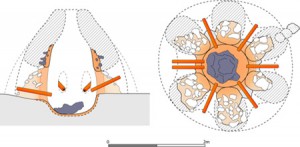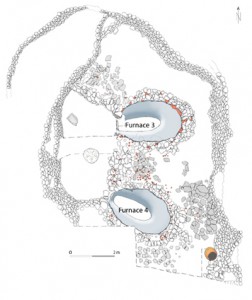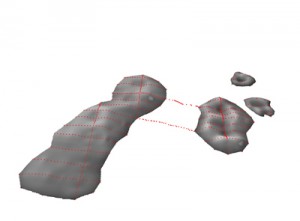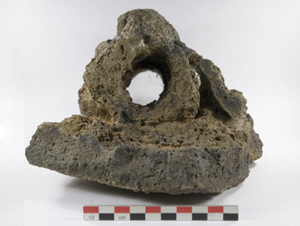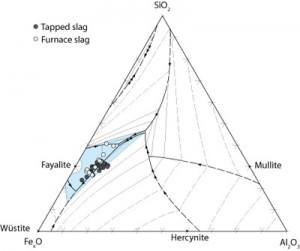Introduction
In the palaeometallurgy section of the project, extensive surveys and an ethnoarchaeological approach were complemented by detailed studies on sites belonging to distinct metallurgical traditions. These make it possible to reconstruct the different stages in the process and to understand the schemes for social and economic structure that underlie such varied siderurgies. These studies were carried out through detailed archaeological excavation of production remains (low shaft furnaces, different plans) and were followed by archaeometric analyses in the laboratory on metallurgical residues (slag, ores, tuyeres, furnace walls).
Archaeological activities
In the field, several aspects were addressed. Test pits and excavations in slag piles exposed low shaft furnaces (fig. 1) and made it possible to reconstruct them. Such work also revealed the spatial organization of sites and the different plans (fig. 2). To date the site and to reconstruct the development of production on sites of long duration, charcoal samples were collected in stratigraphic position. Such samples were collected for anthracological studies, evidencing strategies of exploitation of wood resources, but also the potential ecological impact of iron production on a large scale.
A precise topography of slag piles made it possible to calculate their volumes (fig. 3). To determine the density of the material (the amount of slag per cubic meter), it was crucial to make representative cubings. Based on these data, we can evaluate relatively precisely the weight of the slag at different sites, an essential step in quantifying iron production. The slag (fig. 4) and the other metallurgical residues were sampled for laboratory analysis. The sampling was a critical step and had to be representative. This required a good grasp of the assemblage of these materials, their diversity and their proportions, which varied greatly from one site to another (or between different technological traditions).
Study of metallurgical residues
In the laboratory, chemical (fig. 5) or petrographic (fig. 6) analyses on the different categories of materials had two aims. First, they yielded information on these residues from a technological viewpoint and permitted reconstruction of technical acts, the conducting of reduction operations, the thermo-physico-chemical conditions that existed in a low shaft furnace, etc. Second, it is on the basis of these results that we can establish a summary of the masses (a schema of flow of materials). This provided indications of the efficiency of the procedure, as well as a basis of calculation to quantify the amount of iron produced per ton of slag or at the site scale (fig. 7). If a good chronology exists for the sites, it is then possible to estimate annual iron production, which will ultimately be compared to consumption frequencies, at present too incomplete. These calculations are also of critical importance when discussing possible deforestation, since we can evaluate the amount charcoal needed to produce this iron.
An extraordinary technological diversity
Half a dozen sites have been excavated so far, some extensively. Three sites are currently the subject of laboratory analyses. Initial results evidence the extraordinary technological diversity in the Dogon Country, where we find strictly local production side by side with very large-scale siderurgy. The different metallurgical traditions are identified not only by their technological characteristics (efficiency and management of reduction operations), but also by the structuring of the work space, unique to each group. It is much too early to evaluate the diachronic evolution of these metallurgies and their degree of relatedness. It appears, however, that this diversity, as much at the technological level as organization of production, does not seek to maximize the efficiency of the process, but instead reflects strong social and cultural constraints.

